Tower Heist tells the story of a staff of blue-collared workers taking on greedy Wall Street heavyweight Arthur Shaw, played by Alan Alda, who has swindled the group out of their retirement monies. Shooting in an around New York and on greenscreen sound stages, overall VFX supervisor Mark Russell relied on a combination of visual effects techniques to feature Shaw’s hi-rise apartment in ‘The Tower’ and show the workers concocting an elaborate heist involving a red Ferrari. We speak to the effects supervisors from three of the film’s vendors – Method Studios, Phosphene and Gravity.
Method’s methodology on creating a New York skyline
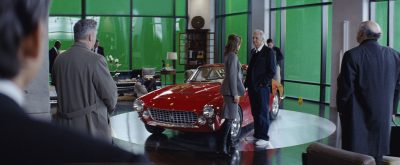
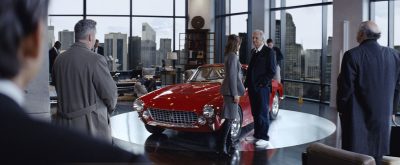
Each vendor on the film completed effects shots filling out views of the Manhattan skyline, either from Shaw’s apartment, on top of The Tower or while the heist was in full operation. Method Studios NY took on 138 shots for the film, the majority being apartment composites to place Shaw’s home in New York. Method also carried out some additional gold prop enhancements, while sister facility Company 3 completed the DI color grade.
In the film, Shaw’s penthouse apartment is located on the 52nd floor of The Tower, matching the location of the Trump International Towers – used as a location for filming – but interior scenes were shot on a soundstage in Brooklyn. Greenscreen was positioned behind the windows with tracking markers both in and outside the set. A LIDAR scan was also taken. “It was an anamorphic show so they were using scope lenses, which made depth of field tight,” notes Method visual effects supervisor Greg Liegey. “The tracking is more difficult because of the distortion but they were going for a more 70s gritty style.”
DoP Dante Spinotti relied on a Steadicam for the majority of interior apartment shots, a further tracking challenge for the visual effects artists. “They would also rack focus while they were walking,” adds Liegey. “That meant the background objects were shifting in focus, and with anamorphic, that means they were actually moving in space. In terms of on the film, they are actually slide around which means everything was changing shape as we track.”
Method used a combination of tracking tools, but predominantly 3D Equalizer, to solve the fluid camera moves, with some in-house tricks for the most complicated set-ups. “Andy Jones at Method NY did develop a half-way between a software solve and a method of creating a plate,” says Liegey. “He would analyze the plate and then use the data he had analyzed to scale the camera back in ways that matched the footage that we were seeing. This added a fudge factor that allowed the world to change shape, which of course can’t really happen.”
For the New York skyline backgrounds that would be composited into the windows, production filmed a set of HDR tiles to match the view from the 52nd floor of Trump International Towers, and relied on a translite for some sequences. “We also went up to the Trump International in May and shot some moving footage because after we did all the temps there were some shots where you wouldn’t see movement in the backgrounds and we needed to,” says Liegey. “In a couple of shots you could perceive in the distance some traffic, and then also on the Hudson River. We saw that as opportunity to add some life to the backgrounds.”
Using Nuke, Method adopted a two and a half D approach to the composites, relying on a CG version of New York inside the software for placement reference. Artists also had an accurate CG model of Shaw’s apartment created from blueprints and the LIDAR scan. Says Liegey: “The camera moves were large enough that you would see parallax between the buildings. So we did put some buildings on their own special geometry. The Time Warner buildings are twin buildings just down the block from the Trump Tower. Those were CG. Others we put on cards or rough CG objects and you could sense the parallax. It also allowed us to put live reflections that would move appropriately.”
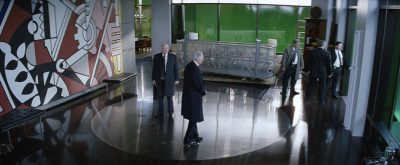
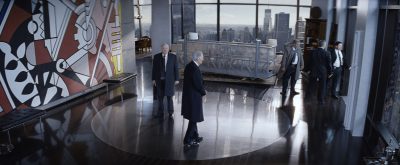
For one particular hero shot, the camera follows the would-be thieves as they confront Shaw in a long tracking move out of an elevator and around the corner of the apartment to reveal the vistas outside the windows and Shaw sitting on a couch. “It was one of the more difficult ones to track,” recalls Liegey, “The inherent floatiness to the Steadicam is tough – you can be accurately tracking it but it still makes the background feel floating – because the Steadicam smooths off the sharp movements that would normally give you the sense that something is matchmoved. So we had to sight that on a lot of shots.”
That shot, and many others, also had to be clear of unwanted reflections. “A lot of the time you had undesirable reflections like the crew and cameras mixed in with the desirable reflections like the artwork on the walls,” says Liegey. “If there was a painting on the wall and the crew was standing in front of it, we would take set reference photos of that painting and actually patch it into the reflections, occasionally using 3D tracks and putting the reflections onto cards in the appropriate place.”
“The reflections would reflect well off the glass and key perfectly from the greenscreen,” continues Liegey, “but the problem is that that is actually the wrong kind of match for a true reflection. It shouldn’t have an alpha. So in cases where you would have reflections of say a painting over a bright sky, it would look completely wrong because the sky would be brighter than that painting reflection and just wouldn’t reflect, but here we had a perfect match for that reflection. Our shorthand for that was a ‘dark reflection’ – it was something reflecting over a bright background that shouldn’t be there.”
A pool on a tower and extending the elevator
Phosphene completed around 70 shots for Tower Heist, the bulk of which were made up of views of Shaw’s luxurious outdoor environment complete with pool and deck on top of The Tower – and scenes inside an elevator shaft.
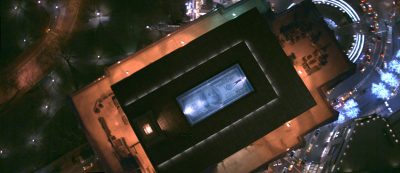 The film’s opening is a pull-back from an image of a $100 dollar bill, revealed to be the bottom of the rooftop pool. A swimmer then passes through frame as the camera pans back to reveal The Tower and the Manhattan skyline. Phosphene removed communications tower and dishes on top of the real Trump Tower and inserted the pool and deck as CG objects.
The film’s opening is a pull-back from an image of a $100 dollar bill, revealed to be the bottom of the rooftop pool. A swimmer then passes through frame as the camera pans back to reveal The Tower and the Manhattan skyline. Phosphene removed communications tower and dishes on top of the real Trump Tower and inserted the pool and deck as CG objects.
“Initially that shot was planned to be just a fairly straightforward stitch between what was filmed on a soundstage – the entire swimming pool and part of the deck – and the second half of a helicopter shot,” explains Phosphene visual effects supervisor John Bair. “Ultimately, the shot needed to be finessed somewhat so we ended up extracting the swimmer out of the shot and then re-built the entire front half of the shot in CG except for the swimmer. The water was a CG sim in 3ds Max and rendered in V-Ray and the shot composited in Nuke.”
Phosphene’s principal effects for the film involved extensions for elevator shaft scenes. Here, the characters ride atop the elevator cab through 60 floors of the tower, actually a 3-storey set piece. The elevator set was LIDAR scanned and extensively photographed for texture reference, then re-built as a CG environment using 3ds Max and V-Ray by the Phosphene team.
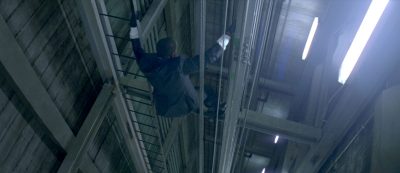 “The way the elevator shaft was built made it difficult to put greenscreen in,” says Bair, “so there was a lot of rotoscoping. We extended the views up and down, which also included the cables. We also filmed several shots with just an elevator car on greenscreen and tracing lights going over the cast, the elevator and the red Ferrari. We added environments around that and comp’d in Nuke.”
“The way the elevator shaft was built made it difficult to put greenscreen in,” says Bair, “so there was a lot of rotoscoping. We extended the views up and down, which also included the cables. We also filmed several shots with just an elevator car on greenscreen and tracing lights going over the cast, the elevator and the red Ferrari. We added environments around that and comp’d in Nuke.”
In completing its elevator shots, Phosphene dealt also, of course, with the anamorphic plates and the challenge of matching close-ups with the VFX extensions. As the edit progressed, the shots also evolved to accommodate faster travelling speeds and wider views of the elevator cab. “At one point,” notes Bair, “they were concerned they weren’t seeing enough of the elevator shaft, so at least two or three shots were invented that let us see the full range looking the full way up or down. It really helped open up and define the sequence a little better.”
Gravity pulls off the heist
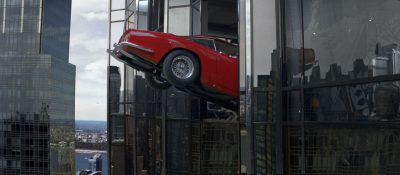 The elaborate Ferrari heist was accomplished by Gravity, which worked on more than 200 shots for the film. The studio mostly helped create the climatic scenes as the characters steel a 1963 Ferrari 250 GT Lusso from Shaw’s apartment through a window high on The Tower before scaling the outside the building with their prized artifact, while the Thanksgiving Day Parade proceeds below. “We previs’d the whole thing,” says Gravity digital effects supervisor Yuval Levy, “and while we were previs’ing we were also trying to figure out what we were going to have to shoot and what we be an extension.”
The elaborate Ferrari heist was accomplished by Gravity, which worked on more than 200 shots for the film. The studio mostly helped create the climatic scenes as the characters steel a 1963 Ferrari 250 GT Lusso from Shaw’s apartment through a window high on The Tower before scaling the outside the building with their prized artifact, while the Thanksgiving Day Parade proceeds below. “We previs’d the whole thing,” says Gravity digital effects supervisor Yuval Levy, “and while we were previs’ing we were also trying to figure out what we were going to have to shoot and what we be an extension.”
The sequence plays out with various views from outside The Tower, looking out from inside and close on the characters who at one point dangle on wires – care of stunts performed mostly against greenscreen. “Production gave us panoramic HDR images,” he adds. “The building was all glass and highly reflective and when they are shooting from the outside into the apartment, we had to reflect something into the window. So we used the same HDR image as a huge translite to reflect onto the set.”
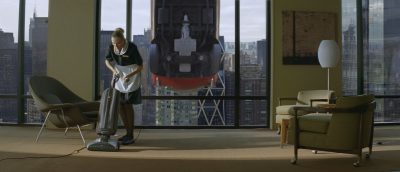 For helicopter views of the action, Gravity re-created sections of New York, including a CG Tower, to augment shots of the action occurring during the Thanksgiving Day Parade. “The director wanted to enhance the shot by moving closer to the building to show the car,” says Levy. “Our first attempt was to zoom into the plate, but it was so degraded and the quality was not there. Also, as we zoomed in we realized if we tilted down a little bit we could see the parade below the building. So we tracked the camera move and then re-created the whole scene in 3D. Then we moved the camera on the axis of the general movement up, which gave us the same tracked move – it was a helicopter shot that felt very realistic, but from a different angle looking down.”
For helicopter views of the action, Gravity re-created sections of New York, including a CG Tower, to augment shots of the action occurring during the Thanksgiving Day Parade. “The director wanted to enhance the shot by moving closer to the building to show the car,” says Levy. “Our first attempt was to zoom into the plate, but it was so degraded and the quality was not there. Also, as we zoomed in we realized if we tilted down a little bit we could see the parade below the building. So we tracked the camera move and then re-created the whole scene in 3D. Then we moved the camera on the axis of the general movement up, which gave us the same tracked move – it was a helicopter shot that felt very realistic, but from a different angle looking down.”
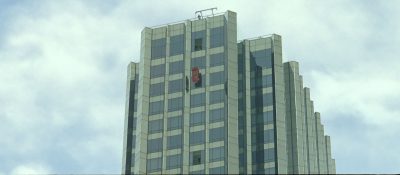 Artists tracked the scenes first in boujou, then exported the camera to Maya and re-created the scene there. “We had to match our Maya elements by figuring out what the lens distortion was from the live plate because of the anamorphic,” says Levy. “We created a set-up early on that each comp artist used. Mark Russell also gave us a grid of the lens distortion for each plate. We’d match that distortion and then also do some manual tweaking to get it right. There’s something about anamorphic lenses that are very organic – it’s not all mathematical.”
Artists tracked the scenes first in boujou, then exported the camera to Maya and re-created the scene there. “We had to match our Maya elements by figuring out what the lens distortion was from the live plate because of the anamorphic,” says Levy. “We created a set-up early on that each comp artist used. Mark Russell also gave us a grid of the lens distortion for each plate. We’d match that distortion and then also do some manual tweaking to get it right. There’s something about anamorphic lenses that are very organic – it’s not all mathematical.”
In Nuke, real plates of the parade shot from the roof of the Trump Tower were augmented to fit the new camera moves, as well as the anamorphic plates. “The whole interior and exterior set was LIDAR scanned,” adds Levy. “We also got a LIDAR scan of that part of Manhattan, including the Trump Tower. Then we positioned the LIDAR scan of the set within the bigger world of the LIDAR scan of Manhattan. So now whenever we tracked a camera in the set environment – when we looked out in the 3D space we saw what you would see from the actual apartment out to New York.”
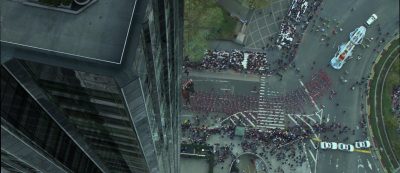 In some scenes, the Ferrari and the actors clinging onto the car and cables were completed in CG. “The most challenging part of the CG car was dealing with shots when it’s very small in frame,” says Levy. “It’s always challenging to make something small look realistic because all the details are very small. You you need to think about which passes will register as a car and which won’t. The same thing went for the digi-doubles as well. Also, when we took the car and rendered it for the helicopter moves, it didn’t look quite right, so had to create different set-ups for medium and long shots.”
In some scenes, the Ferrari and the actors clinging onto the car and cables were completed in CG. “The most challenging part of the CG car was dealing with shots when it’s very small in frame,” says Levy. “It’s always challenging to make something small look realistic because all the details are very small. You you need to think about which passes will register as a car and which won’t. The same thing went for the digi-doubles as well. Also, when we took the car and rendered it for the helicopter moves, it didn’t look quite right, so had to create different set-ups for medium and long shots.”
Levy also notes that even some close-up views of the Ferrari required a CG version of the car. “Some medium shots of the car were shot in an environment where the translite was not big enough for every shot as the car was rotating, and so it would reflect parts of the greenscreen and required a CG replacement.”
All images and clips copyright 2011 Universal Pictures.
